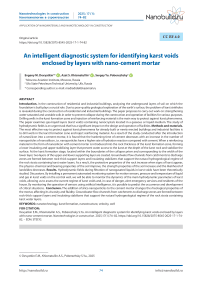An intelligent diagnostic system for identifying karst voids enclosed by layers with nano-cement mortar
Автор: Devyatkin E.M., Khismatullin A.S., Poberezhsky S.Yu.
Журнал: Nanotechnologies in Construction: A Scientific Internet-Journal @nanobuild-en
Рубрика: Application of nanomaterials and nanotechnologies in construction
Статья в выпуске: 1 Vol.17, 2025 года.
Бесплатный доступ
Introduction. In the construction of residential and industrial buildings, analyzing the underground layers of soil on which the foundation is built plays a crucial role. Due to poor-quality geological exploration of the earth's surface, the problem of karst sinkholes is revealed during the construction of residential and industrial buildings. The paper proposes to carry out work on strengthening water-saturated and unstable soils in order to prevent collapse during the construction and operation of facilities for various purposes. Drilling wells in the karst formation zone and injection of reinforcing material is the main way to protect against karst phenomena. The paper examines gas-liquid layers (karst voids) containing nanocrystals located in a gaseous or liquid medium. The study of hydrodynamic fields is an urgent task that has a significant impact on the design and operation of facilities. Methods and materials. The most effective way to protect against karst phenomena for already built or newly erected buildings and industrial facilities is to drill wells in the karst formation zone and inject reinforcing material. As a result of the study conducted after the introduction of nanosilicon into a cement mortar, it is found that the hardening time of cement decreases with an increase in the number of nanoparticles of nanosilicon, i.e. nanoparticles have a higher rate of hydration reaction compared with cement. When a reinforcing material in the form of nanosilicon with cement mortar is introduced into the rock thickness of the karst formation zone, forming a lower insulating and upper stabilizing layer that prevent water access to the karst at the depth of the karst rock and stabilize the surface. At the karst formation stage, located within the boundaries of the collapse prism and corresponding to the width of the lower layer, two layers of the upper and lower supporting layer are created. Groundwater flow channels from catchments to discharge zones are formed between rock-thick support layers and insulating stabilizers that support the natural hydrogeological regime of the rock strata containing karst water layers. As a result, the protective properties of the rock increase when signs of karst appear, the physico-chemical and bearing properties of the soil improve, the strength properties of the soil increase and the likelihood of landslides decreases. Results. Hydrodynamic fields during filtration of nanogasated liquids in karst voids have been theoretically studied. Discussions. By installing a permanent automated monitoring system for motion sensors, pressure and temperature of liquid and gas in karst voids on the control well, we will be able to monitor the dynamics of the main hydrodynamic parameters of karst voids, allowing us to assess the current regime of karst voids and, in case of danger, alert emergency services and residents of the house. By monitoring the operation of sensors using artificial intelligence, it is possible to predict the occurrence and development of critical situations. Conclusion. The addition of silica nanoparticles to the cement mortar changes the rheological properties of the mortar, affecting its viscosity and fluidity. Groundwater flow channels from catchments to discharge zones are formed between rock-thick support layers and insulating stabilizers that support the natural hydrogeological regime of the rock strata containing karst water layers.
Nanotechnology, karst formation, nanostructure, velocity, well
Короткий адрес: https://sciup.org/142243359
IDR: 142243359 | DOI: 10.15828/2075-8545-2025-17-1-74-82
Текст научной статьи An intelligent diagnostic system for identifying karst voids enclosed by layers with nano-cement mortar
Original article
In the construction of residential and industrial buildings, an analysis of the underground layers of the earth on which the object stands plays an important role. Due to poor-quality geological exploration of the earth’s surface, the problem of karst sinkholes is revealed during the construction of residential buildings and industrial buildings. The paper proposes to strengthen swampy and structurally unstable soils, preventing collapses during the construction and operation of facilities.
METHODS AND MATERIALS
Microsilicon was widely used after 1960 and at this time it is becoming in demand. However, this significantly complicates the process of preparing cement mortar, since, for example, additional technical equipment is required to introduce such an amount of solid, waterinsoluble substances into the mixture into the well. Nanostructured silica is a highly active cement additive containing ultrathin particles, the main component of which is represented by an amorphous modification of silicon dioxide. The increase in the strength of the material is explained by the small particle size, which contributes to the interaction with calcium hydroxide and a significant compaction of the material structure. This process helps to increase the mechanical strength of the cement material, and microspheres fill the space formed as a result of hydration [12].
It is found in [13–14] that after the introduction of nanosilicon into cement mortar (NCCR), the cement solidification time decreases with an increase in the amount of silica nanoparticles. Consequently, nanomaterials have a higher rate of hydration reaction compared to cement.
Protection against karst manifestations under the foundation in residential and industrial buildings that have already been built or recently put into operation is based on drilling wells in this zone and pumping a cement solution containing silica nanoparticles (NCCR) into the rock thickness. When the NCCR is introduced into the rock thickness in the karst formation zone, two layers arise: the upper one is a bearing layer and the lower one is an insulating layer that restricts water access to the karst from below. The first well is drilled obliquely to the upper transition zone of the geological layer prone to karst formation, and the NCC is introduced to a depth of about 10 meters to create a lower insulating and stabilizing layer. The second inclined well is drilled under karst voids, in front of groundwater, and a liquid solution of NCCR with a thickness of about 5 meters is poured. The third well, the control one, is drilled vertically until the upper support and the lower insulation come into contact. Between the upper and lower layers in the middle karst
layer, groundwater runoff channels arise from basins to discharge zones that support the natural hydrogeological regime of the karst layer layers.
As a result, the protective properties of the rock increase, the chemical and physical properties of the soil improve, the strength properties of the soil increase and the probability of landslides decreases.
The paper further proposes to investigate the gasliquid layers in the control well, which are located in a gaseous or liquid medium. These systems can combine the properties of both gases and liquids, creating unique characteristics such as high fluidity and small particle size. The study of hydrodynamic fields in the filtration of noncarbonated liquids is an urgent task that has a significant impact on the design and operation of wells.
MATHEMATICAL FORMULATION OF THE PROBLEM
The task of studying the temperature field during filtration of carbonated liquid is an important task in describing the movement of fluid in karst voids. This is due to the fact that karst voids contain a significant amount of gas, due to which, under certain external and internal factors, the upper layer may collapse.
The saturation pressure is equal to the reservoir pressure, therefore, during the movement of water in a formation with karst voids, degassing occurs. Under these conditions, the temperature drops both due to heat absorption during the phase transition and due to atmospheric thermal effects of the gas phase, and the flow of the liquid phase causes an increase in temperature. At low gas solubility, the formation heats up, and at high gas-liquid flows it cools down.
When the saturation pressure is lower than the reservoir pressure, two water flow options are possible. The first option is a single-phase flow that heats up due to the pressure in the well greater than or equal to the saturation pressure, accompanied by heating due to the Joule-Thomson effect.
If the saturation pressure is in the gap between the pressure in the formation with karst voids and the pressure in the well, then a bidirectional flow is realized. In an area where the pressure exceeds the saturation pressure P s < P < P h , a single-phase flow occurs, accompanied by heating. In an area where the pressure is less than the saturation pressure P w < P < P s , A bi-directional, oncoming flow of water and gas is realized, accompanied by phase transitions, and a high gas solubility coefficient cools the flow.
The physical properties of water and gas in karst voids differ both in the depth of the formation and horizontally, that is, the karst layer is generally anisotropic. But for simplicity, we believe that the karst layer is porous and the surrounding rocks are homogeneous in hydrodynamic and thermophysical properties. We also believe that
APPLICATION OF NANOMATERIALS AND NANOTECHNOLOGY IN CONSTRUCTION the permeable layers are located horizontally and are surrounded from above and below by impermeable rocks with a solidified solution of NCCR.
Picture 1 shows the geometry of the problem under consideration, where the inflow of carbonated water occurs to a well of radius r 0 .
When solving the problem, we use a cylindrical coordinate system, the axis z which coincides with the axis of the well, and point z = 0 is located in the center of the karst formation (– h < z < h ), where h – the half-thickness (half-thickness) of the formation, and its thickness (or capacity) is equal to twice the half-thickness ( H = 2 h ). Thermophysical properties along the vertical axis (thermal conductivity λ z and thermal conductivity a z ) differ from the corresponding properties along the horizontal axis r (λ r and a r – accordingly). Assume that the pressure and temperature inside the formation do not depend on the angular coordinate φ. In the field of z < h is impermeable rocks with thermophysical parameters are located (λ z 1 , a z 1 , λ r 1 , a r 1 ), and in the field z < – h – with thermophy z sic z al parameters (λ z 2 , a z 2 , λ r 2 , a r 2 ).
In the area from the power supply circuit R k up to the saturation radius r s . A single-phase water flow is realized (on Fig. 1 – area I). Well pressure P w is less saturation pressure P s , achieved when r = r s in formation – h < z < h , where r s – saturation radius. Hence on the area r 0 < r < r s there will be a two-phase flow of water and gas (in Fig. 1, this area is darkened, zone II).
Consider the energy equations of the carrier phase consisting of water, dissolved gas, free gas (pure gas) and the skeleton of a karst porous medium, transformed into one equation using a single-temperature approach.
The energy equation for the saturated phase is written as an equation with an index i . The value of index i = 1 corresponds to water, i = 2 – dissolved gas, i = 3 – free gas – gas phase:
qp/ 〃 ^ + ^^[grad T,-+ &1gradP]-ms^^ 三=
=div^ms^gradT^-L^i+^^i-T^, (1)
where L i – specific heat of the phase transition i -th components, and q i – volume density of the free gas source.
If we add up the formulas for the energy of all phases and components, making their temperatures equal, we get:
Z 例 SRG + (1 — 相) PoCo 臨 + Z Gq , q (gradT + qgradP)-
-2>s , P£Q ^ + 24% = div ^ms^^^-m)^ gradT . (2)
By converting, we get:
w E«,.p,.c,. Z6PQ0
:+ Г----------------nVT + p--------------- ^vp -
XmsiPici +(l-m) poco EmSiPa+Q-m) poco
屮 з , 空+ =
E^zP^+Q-^PoCo 欠 Z 侬RS + (1-次)Po% div [z^s;% + (1 -根)九o) gradT
£W5,P,C,. +(l-W ) p0C0
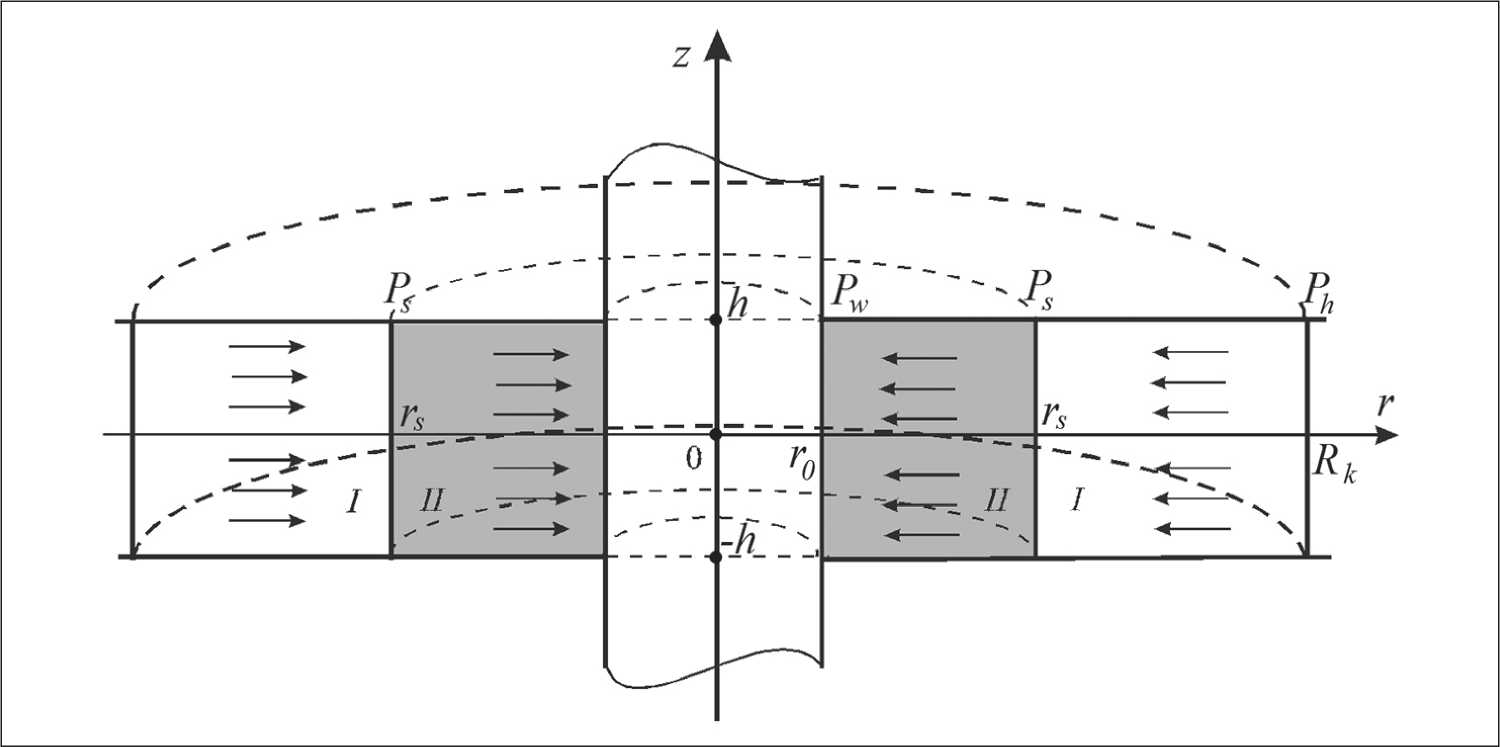
Fig. 1. Setting the problem
APPLICATION OF NANOMATERIALS AND NANOTECHNOLOGY IN CONSTRUCTION
This equation can be presented in a form corresponding to a single-phase flow equation with effective parameters:
If the consumption of carbonated liquid is equal i = 1, 2, 3, then, taking into account the equality of the filtration rate of water and the gas dissolved in it, we get:

, (4)
where
汇服* P,£
□ = ^------,
一叫% +(1-加瓦 an=—-----------,
2 msiP£+(l 一 "%000
% = Х/и*Р№+(1 — т)РоСо ,
εef – effective Joule-Thomson coefficient, иef – effective rate of convective heat transfer, η ef – effective adiabatic coefficient.
The expression of the effective rate of convective heat transfer for a single-phase flow has the form:
и =_______ (С1Р1+С2Р2 ) О1+СзРз°з _______
” 叫 PiG+ms2P2c2+ 叫 Рз°з+(1-m)poCo'
%- 土[(。他 + C2P2 ) 出 + езрз ■[《• (9) e J Hi r3 」办
For a homogeneous isotropic porous medium for the effective Joule–Thomson coefficient, substituting, we obtain
Ejucq?
〜: .
2 決科
If you express υ i , then we get:
»>ср/ ( 5 ) Лч
.
%=」 . (5)
In an isotropic homogeneous medium, the vectors и ef and и i are collinear, since they obey Darcy’s law, they thus coincide in direction with the pressure gradient:
In [4–13], it was shown that the value of the effective Joule-Thomson coefficient clearly does not depend on the permeability, pressure gradient, and heat capacity of a porous medium.
Consider the flow of carbonated liquid at i = 1, 2, 3, given the equality of the filtration rate of water and the gas dissolved in it, we obtain:
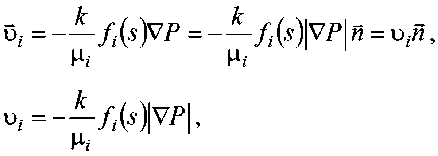
(呼问+脏 2P2 ) 5+£3 吃 3p3 ( С1Р1+С2P2 ) 5 +U3C3P3
where п – the unit vector in the direction of the pressure gradient.
If you convert the filtration rate formula i -th the phases in the formula for the effective convective heat transfer rate, we obtain:
Uef= к ^CiPifi^P\.n . (7)
The rate of convective heat transfer and the rate of phase filtration for a one-dimensional flow are also co-direc ti onal and directed along the axis r , that’s why и i = υ i J r , и ef = Uef r , we get: i
The heat capacity of the karst layer of the formation is determined by the expression
凄=加 S1PG + 例 S2P2s + 初 S3P3C3 + (1 —例 )poco. (13)
When filtering carbonated liquid, the corresponding expression for the adiabatic coefficient is represented as:
XPE1 +S2P202rl2 +S3P3C3% S1PQ+S2P2c2+S3P3S

Theoretical and experimental studies of temperature fields during filtration of liquid and gas in a porous medium were carried out by A.I. Filippov, M.R. Minlibaev, E.M. Devyatkin, P.N. Mikhailov and others in 1980– 2015 [8–14]. In the works of V.V. Dryagin, Ya.R. Adiev, A.A. Shilov, V.N. Fedorov, V.M. Meshkov, A.S. Bochkov, A.M. Sharipov, A.A. Sadretdinov, and others, temperature zones are taken into account during joint filtration of water and carbonated liquid [12–25].
APPLICATION OF NANOMATERIALS AND NANOTECHNOLOGY IN CONSTRUCTION
The formula for the effective Joule–Thomson coefficient for filtering carbonated liquids is as follows:

_ qq+e2c2g3+ 与 e3 3
2 1—a% 1—a 尸’ з i—aP
Due to the lack of degassing at high saturation pressures, the Joule-Thomson coefficient for filtration of carbonated water is as follows:
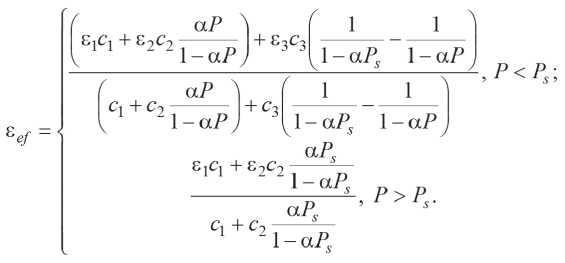
The formula for the effective Joule–Thomson coefficient of pressure has the form:
七 1 ( P£7 + P202rlаНЬРзСзПз p .
OM + p2c2 ) ' "
PE% + P2c2n2 p
P1G+P2c2 ' S' (17)
The effective rate of convective heat transfer is written as:
Р15 ( С1+С2^з ±£^1Ж±Ы
机 P 《 1 ( Q + С? 己 з ) + mg Р3С3 己 2 + (1 - 机 Во/ 化 1 + 己 2 )'
RESULTS
aPs
Pi°i с*2
i 一叫
|
小 P1 |
+ (1-/и)росо |
,尸>巴•
In Fig. 2, curve 1, it can be seen that the temperature in the range –1 < z < 1 is constant.
The first decomposition coefficient in this range takes both negative and positive values (curve 2). To correct the correctness of the solution, we add the zero and the first approximation of the temperature distribution (curve 3), which is expressed as a function of the temperature field on z . Figure 2 shows that in the central part of the formation, for short times, the zero approximation describes the temperature distribution with a disadvantage, and at the edges of the formation with an
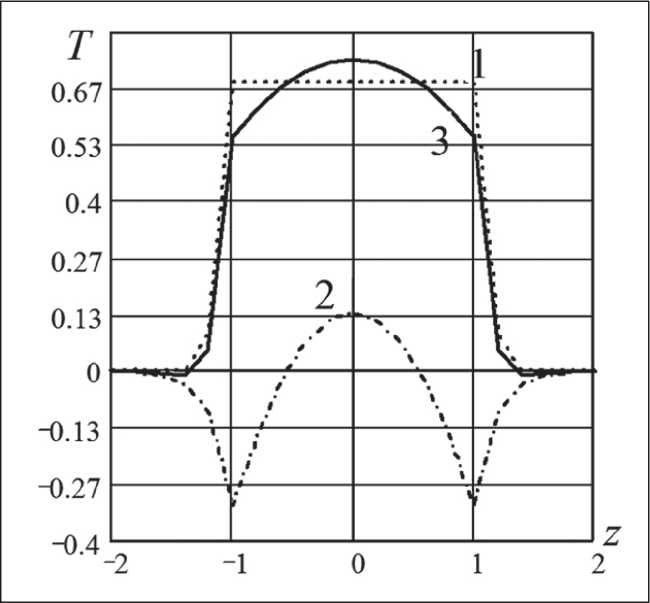
Fig. 2. Graphs of the dependence of dimensionless temperature T from the coordinate z in dimensionless coordinates: h = 1 м , R k = 50 м , t = 0.01; ε = 0.25
excess. In environments, the zero approximation always gives an excessive temperature value.
DISCUSSION
By installing a permanent automated monitoring system for motion sensors, pressure and temperature of liquid and gas in karst voids on the control well, we will be able to monitor the dynamics of the main hydrodynamic parameters of karst voids, allowing us to assess the current regime of karst voids and, if danger arises, signal this.
Thus, using mathematical dependencies and data from the continuous monitoring system, we will be able to determine porosity, moisture content and gas content in the intermediate layer with karst voids.
CONCLUSION
The use of nanosilicon-cement mortar in the lower and upper layers allows:
– to increase the protective properties of rocks during karst phenomena;
– improve the reliability of the physical, chemical and bearing properties of the soil;
– to increase the strength characteristics of the soil;
– reduce the likelihood of emergencies:
– automate the technological process of hydrodynamic research in karst environments.
The addition of silica nanoparticles to the cement mortar changes the rheological properties of the mortar, affecting its viscosity and fluidity. This can improve filtration through porous materials. The presence of
APPLICATION OF NANOMATERIALS AND NANOTECHNOLOGY IN CONSTRUCTION
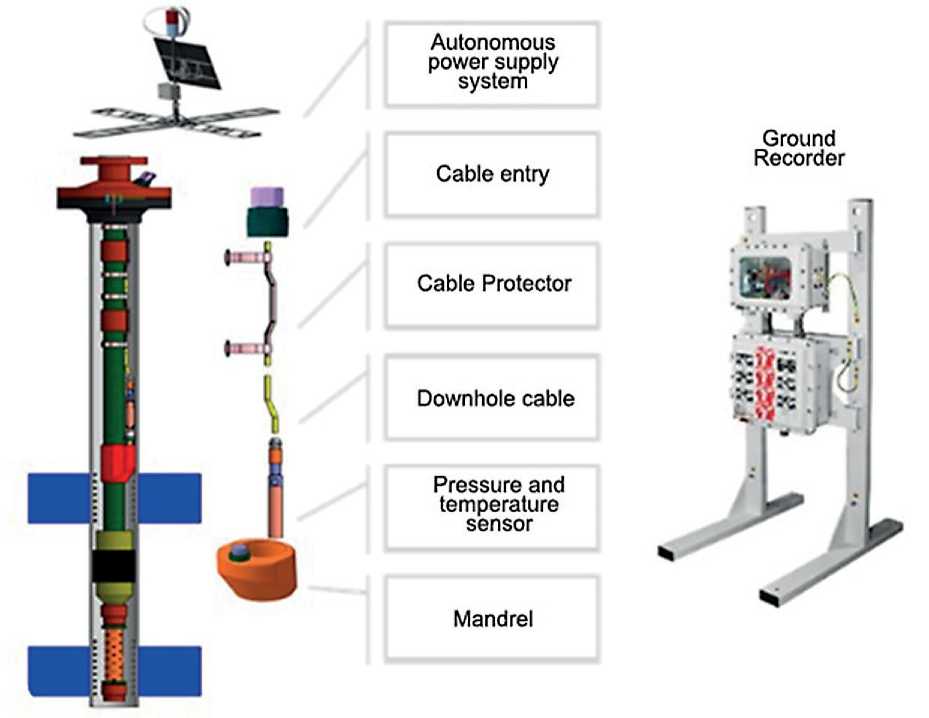
Fig. 3. Continuous monitoring system
gases in the liquid creates an additional lifting force effect and changes the flow behavior, which affects the pressure and filtration rate. A channel is formed between the dominant layer of the rock strata and the insulating stable layer for groundwater flow from the catchment area to the discharge zone, while maintaining the natural hydrogeological conditions of the rock strata, including the presence of water in the karst formation zone.
The advantages of using this development in construction:
-
• Consideration of hydrodynamic fields will help to design more stable foundations and structures, avoiding possible subsidence or destruction.
-
• Using nanotechnology to create sensors that will track changes in hydrodynamic fields and soil properties.
-
• The design of foundations taking into account the filtration properties of carbonated liquids to prevent subsidence and destruction.
The problem of filtration of carbonated liquid in karst voids is investigated. The resulting equation is used to calculate and analyze the spatiotemporal temperature distribution over time during filtration of carbonated liquid in karst voids. The study of hydrodynamic fields in the filtration of non-carbonated liquids is an urgent task that has a significant impact on the design and operation of wells.
Список литературы An intelligent diagnostic system for identifying karst voids enclosed by layers with nano-cement mortar
- Poberezhsky S.Y. «Universal measuring pulse generator». Depositor. in VINITI 02.06.2014. № 152; 2014.
- Poberezhsky S.Y. Thermal conductivity of binary solutions of organic liquids by Evell classification groups. Modern problems of science and education. 2014; 4. Access mode: http://www.science-education.ru/118-13977
- Poberezhsky S.Y. «Experimental studies of the thermophysical properties of binary and ternary solutions of
- organic heat carriers». 10th International Conference «Aviation and Cosmonautics – 2011». Moscow: MAI, November 13-15;2011.
- Khismatullin A.S. Method for increasing oil resources transformers with longterm operation. In the collection: IOP Conference Series: Materials Science and Engineering. 2018; 022058. https://doi.org/10.1088/1757-899X/327/2/022058
- Filippov A.I., Mikhailov P.N., Khismatullin A.S. Filtration-wave heating of an oil reservoir. Engineering physics. 2006;5:13-21.
- Filippov A.I., Devyatkin E.M. Barothermal effect in a gas-bearing stratum. High Temperature. 2001; 39(2): 255-263. https://doi.org/10.1023/A:1017526900775
- Devyatkin E.M. Computer modeling of experimental problems in general physics. Modern problems of science and education. 2017; 6:178.
- Filippov A.I., Mikhailov P.N., Bagautdinov R.N., Potapov A.A., Filippov K.A. Temperature fields in oil-gas beds exposed to the action of an acid. Journal of Engineering Physics and Thermophysics. 2005;78(2):256-271. https://doi.org/10.1007/s10891-005-0056-z
- Filippov A.I., Mikhailov P.N. Specific features of the displacement of liquid during filtration in a low-porosity medium. Journal of Engineering Physics and Thermophysics. 2022;95(3):721-727. https://doi.org/10.1007/s10891-022-02529-4
- Valiullin R., Ramazanov A., Khabirov T., Sadretdinov A., Kotlyar L., Sidorova M., Fedorov V., Salimgareeva E. Interpretation of non-isothermal testing data based on the numerical simulation. In the collection: Society of Petroleum Engineers - SPE Russian Conference on Petroleum Technologies; 2015. https://doi.org/10.2118/176589-MS
- Akchurin R.Z., Davletshin F.F., Ramazanov A.Sh., Sharafutdinov R.F. Thermal field in a well during induction heating of a casing string under conditions of low flow velocity. Proceedings of Tomsk Polytechnic University. Georesource engineering. 2023;34(2):87-98. https://doi.org/10.18799/24131830/2023/2/3807
- Valiullin R.A., Ramazanov A.Sh., Khabirov T.R., Sadretdinov A.A., Zakirov M.F., Sharafutdinov R.F., Yarullin R.K. The experience of using simulators in the interpretation of thermal and thermohydrodynamic studies. Proneft. Professionally about oil. 2022;7-1(23):99-109. https://doi.org/10.51890/2587-7399-2022-7-1-99-109
- Vasilev I., Hismatullin A. The theory of fuzzy sets as a means of assessing the periods of service of asynchronous electric motors. Proceedings - 2020 International Conference on Industrial Engineering, Applications and Manufacturing, ICIEAM 2020. 2020;9111887. https://doi.org/10.1109/ICIEAM48468.2020.9111887
- Vijayan D.S., Devarajan P., Sivasuriyan A. A review on eminent application and performance of nano-based silica and silica fume in the cement concrete. Sustainable Energy Technologies and Assessments. 2023;56:103105. https://doi.org/10.1016/j.seta.2023.103105
- Zimina D.A., Zhapkhandaev C.A., Petrov A.A. Analysis of the Effect of Nanosilicates on the Strength and Porosity of Cement Stone, Key Engineering Materials. 2020;854:(175-181). https://doi.org/10.4028/www.scientific.net/KEM.854.175
- Balea A., Blanco A., Negro C. Nanocelluloses: Natural-based materials for fiber-reinforced cement composites. A critical review. Polymers 2019;11:518. https://doi.org/10.3390/polym11030518
- Guo A., Sun Z., Sathitsuksanoh N., Feng H. A review on the application of nanocellulose in cementitious materials. Nanomaterials. 2020;10(12):2476. https://doi.org/10.3390/nano10122476
- Berra M., Carassiti F., Mangialardi T., Paolini A., Sebastiani M. Effects of nanosilica addition on workability and compressive strength of Portland cement pastes, Construction and Building Materials 2012;35:666-675. https://doi.org/10.1016/j.conbuildmat.2012.04.132
- Davletshin F.F., Ramazanov A.Sh., Akchurin R.Z., Sharafutdinov R.F., Islamov D.F. Investigation of the thermal field in a well during the column motion of a liquid during induction action. Proceedings of Tomsk Polytechnic University. Georesource engineering. 2023;34(3):153-164. https://doi.org/10.18799/24131830/2023/3/3896
- Ramazanov A.S., Parshin A.V. Analytical model of temperature variations during the filtration of gas-cut oil. High Temperature. 2012;50(4):567-569. https://doi.org/10.1134/S0018151X12040189
- Valiullin R.A., Sharafutdinov R.F., Zakirov M.F., Ramazanov A.S., Sadretdinov A.A., Khabirov T.R. Investigation temperature field in a horizontal well with multiple fractures. Saint Petersburg 2018: Innovations in Geosciences & Time for Breakthrough. 2018;44629. https://doi.org/10.3997/2214-4609.201800301
- Mullakaev R.M., Mullakaev M.S. Ultrasound in the processes of purification of oil-contaminated wastewater: an overview. Ecology and industry of Russia. 2021; 25(3):53-59. https://doi.org/10.18412/1816-0395-2021-3-53-59
- Bashirov M.G., Bashirova E.M., Yusupova I.G., Akchurin D.Sh., Yulberdin R.T. Identification of the stressstrain state and damage to the metal structure of building structures with nanocoating by electromagnetic-acoustic method. Nanotechnology in construction. 2023;15(5):482-493. https://doi.org/10.15828/2075-8545-2023-15-6-552-558
- Khismatullin A.S., Gareev I.M. Investigation of the transfer of an integral parameter in liquids with gas bubbles. Ecological systems and devices. 2015;7:38-42.
- Nigmatulin R.I., Filippov A.I., Khismatullin A.S. Transcilatory heat transfer in liquids with gas bubbles. Thermophysics and aeromechanics. 2012;19(5):595-612.

